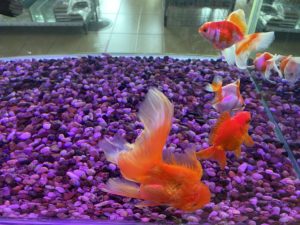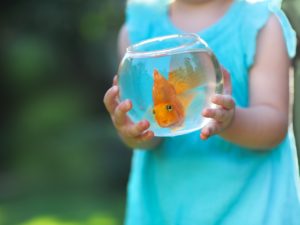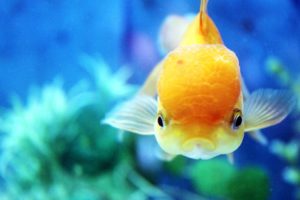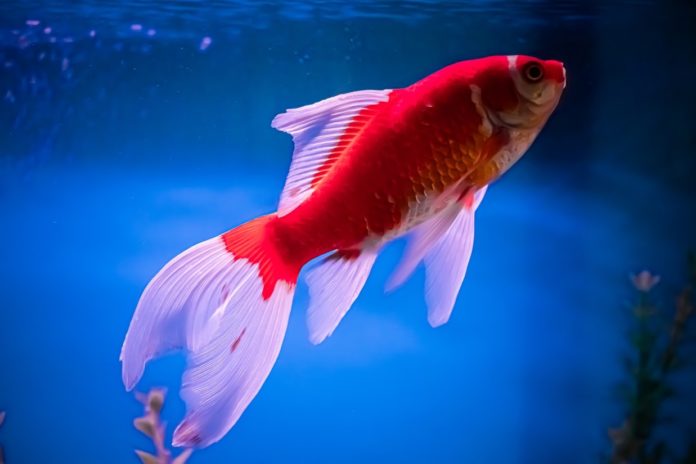The Basics of Goldfish Care: How To Take Care Of Your Goldfish!
Goldfish have been kept as pets for centuries, originally being kept in ponds. Goldfish became domesticated and genetically distinct from their chi ancestors in the 9th century when Buddhist monks in China began to keep them safe from predators. Goldfish became domesticated and genetically distinct from their chi ancestors in the 9th century when Buddhist monks in China began to keep them safe from predators. By the 1500s, goldfish were commonly kept inside bowls as a show of wealth and status, although they should always be outdoors in natural conditions.

Goldfish Tank Setup
Goldfish require adequate living arrangements just like any other pet. The initial setup cost of a bowl or aquarium, food, a water testing kit, and water treatments will all add to the price of being a goldfish owner. A basic setup for one common goldfish can be done for around $50 but can easily go into the hundreds for larger aquarium and filtration setups. Goldfish are a common fish kept in tanks of all sizes. Goldfish are peaceful and easy to care for. There are many different types of goldfish, each with its own color and personality.
Tank setup is simple – just provide a comfortable home for your goldfish! Goldfish should be kept with other non-aggressive fish that will not compete for food or territory. Goldfish tanks can be used as a home aquarium or classroom demonstration tank. Goldfish are small, hardy fish that need warm water and filtration. A gravel substrate is important for goldfish because it provides hiding places and allows them to dig for food. The best time of year to set up a goldfish tank is spring or fall, when the weather is cooler but the water isn’t too cold yet.
Why Goldfish Should Not Be Kept in Bowls?
Goldfish should not be kept in bowls because it is not a pet. Goldfish are not pets. Goldfish are not meant to be kept in bowls. Goldfish are not meant to be kept in bowls. Goldfish should not be kept in bowls. Goldfish should not be kept in bowls. Goldfish should not be kept in bowls. Goldfish should not be kept in bowls. Goldfish should not be kept in bowls. Goldfish should not be kept in bowls. Goldfish were originally kept in large ceramic basins that were much roomier than the cramped desktop bowls of today. Goldfish are easy to care for and make good beginner fish, which contributes to their popularity.

To keep them healthy, you will need to regularly clean the tank and perform partial water changes every 1-2 weeks. Swim bladder disease is a common issue that causes your fish to float on the surface or sit at the bottom of the tank; you should avoid feeding them for 24 hours and then introduce fibrous foods like vegetables after that. Skin diseases are common too, including parasites or bacteria causing spots and color changes, fancy Goldfish being particularly prone to illness because they are much more delicate. If you notice that a fish is sick, then you should move them to a quarantine tank. Goldfish should not be kept in bowls because they can easily spread diseases to other fish in the household.
Goldfish Tank Size
Larger tank size is important because goldfish are not known for their cleanliness. As these solid wastes break down, they consume oxygen and generate toxic metabolic by-products such as ammonia. Larger tanks allow for easier handling of issues such as more dilute water and installation of an adequate water filtration system. Larger tanks also offer greater space for goldfish to swim and dive.
Goldfish Tank Temperature
Goldfish require a heater to maintain stable temperatures. Goldfish thrive in waters between 23°C and 25°C, with a temperature range of 10°C – 12°C during winter and 20°C – 23°C in summer. When introducing new goldfish into the tank, they should be floated until their water temperature is the same as the tank they are going into to avoid shock. Common goldfish are generally peaceful fish and can be good tank mates for other peaceful fish, like platys, danios, and guppies.
Goldfish should be kept at a temperature of 79 degrees Fahrenheit (26 degrees Celsius). Goldfish can tolerate temperatures up to 86 degrees Fahrenheit (30 degrees Celsius). Goldfish can be cooled by ice or cold water.
Water and Filtration Requirements
Goldfish generate copious amounts of waste, so you will need a powerful aquarium water filter (such as a properly sized canister filter) and to be diligent about cleaning their tank. Hang-on-the-back types of filters work great for goldfish but must be greatly oversized to meet the task. The additional aeration created by an air diffuser (e.g., bubble wand) can help with water circulation and gas exchange. These devises should, however, be used very carefully with certain goldfish varieties (e.g., bubble-eyes). Goldfish like water where the alkalinity is higher than the acidity, so water with a pH between 7.0-7.4 is best.
Goldfish are heavy feeders and high waste producers and require efficient filtration of a suitable size to maintain water quality and for aeration. Good filtration will ensure all water is regularly filtered mechanically and biologically via the nitrifying bacteria in the filter media. If the filter does not create bubbles or stir the surface water, an aeration system (such as air stones) can also be attached to ensure that water is well oxygenated. This is important due to the high amount of waste goldfish produce.

Goldfish Tank Decorations
Pea gravel (as opposed to sand or finer gravels) is best for the substrate, as the fish can more easily avoid ingesting it when slurping bits of food from the tank floor.
Decorative stone, artificial plants, etc., add a nice touch but should be used minimally as to leave the most swimming space. Live plants can be used only with caution, as goldfish are known to consume all but the toughest or least palatable types (try anubias or java fern.). Once you’ve purchased your tank, filter, decorations and other equipment you’ll have to set everything up before you can top it off with water. Rinse and add your substrate to the bottom, set-up the filter and lights and add your decorations to the tank. Once the water is added, turn on your heater and filter and adjust the settings.
Many sites talk about the nitrogen cycle in goldfish aquariums, but they often miss a key point—You can cycle an empty tank for months and still have no healthy bacteria populations. Cycling alone is not enough; you have to actually add some good bacteria to your tank for it to grow and spread. You can get the bacteria along with some substrates or add it in a liquid form to your tank (see below). Alternatively, you can take some old substrate or media from an existing tank and place it in your cycling tank to start the process. Many fish stores will give you some of their used substrate or water from a healthy tank for free, too.
Goldfish Food
Goldfish are omnivores that eat both plants and animals. Goldfish benefit from a high carb-to-protein content food. Stick to a quality, specially formulated goldfish diet with occasional “treats” in between. And don’t overdo it! Beyond voracious, goldfish simply don’t know how to stop eating and will harm themselves if presented with too much food.
Pre-Soak Your Goldfish’s Food
Goldfish are natural bottom-feeders and when flakes sit on top of the water they can upset their swim bladder and equilibrium – this can cause them to float upside down. To pre-soak your goldfish’s food, fill a cup with some water from the tank and swirl around their meal in the water – then dump the whole cup into the tank for your goldfish. Goldfish have large appetites but should be able to consume all the food you offer within two minutes offeeding. If there is food in the aquarium after this time has elapsed, this will contribute to poor water quality and make your goldfish more susceptible to disease
Goldfish need cover to reduce stress and improve immune system. Provide half to three fourths of the tank space with hiding places for your goldfish. Pre-soak your goldfish’s food to reduce chances of illness or parasites.
Goldfish Diseases
Goldfish can suffer from a variety of illnesses, some of which may be detected by checking water conditions. Keeping a close eye on your goldfish and regularly checking water conditions will improve their health. You can enjoy $10 off your first online order when you sign up for the My Pet Warehouse newsletter.

